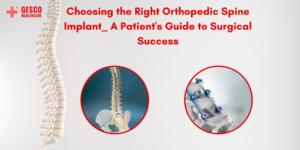Spinal fusion treatments in particular require the use of spine implants and instruments to be successful. In order to facilitate recovery, these implants—which include pedicle screws and rods, plates, interbody cages – offer essential support. In addition to being essential for the success of the surgery, selecting the best spine implant is also important for the long-term health of the patient. In order to guarantee a successful surgical procedure, we examine different kinds of spine implants in this guide and provide advice on choosing the best one.
Types of spine Implants
Let’s begin by understanding the different types of spine implants
Pedicle Screws and Rods
Pedicle screws and Rods are fundamental spine implant components, crucial for stabilizing the spine and maintaining proper alignment during fusion. Made from high-quality materials like Grade 23 titanium, they provide stability and structural support in various sizes and configurations.
Plates
Plates, such as cervical and lumbar plates, are designed to offer additional support and stability. Surgeons can apply them to the anterior or posterior aspects of the spine, depending on the chosen surgical approach.
Interbody Cages
Interbody cages are implants that restore disc height and alignment, facilitating bone fusion. They come in various sizes and shapes, made from materials such as titanium, PEEK, 3D printed bio-materials or carbon fiber-reinforced polymers.
Bone Grafts
In spinal fusion procedures, bone grafts promote bone growth and fusion between adjacent vertebrae. Autografts, taken from the patient’s body, or allografts, from cadaver donors, are commonly used in conjunction with other spine implants to enhance fusion.
Selecting the Ideal spine Implant
Choosing the right spine implant is a crucial decision for the success of spinal surgery. Consider these key factors when selecting the ideal spine implant:
Surgical Approach
The surgical approach chosen by the surgeon is crucial in determining the type of spine implant. Different approaches, such as anterior, posterior, and lateral, have unique requirements, and the implant should align with the chosen approach for compatibility and effectiveness.
Patient Anatomy
Each patient’s spinal anatomy is unique, and the implant must accommodate these specific characteristics. This may involve selecting the right size, shape, and material. Customized implants may be required for patients with larger or smaller vertebrae to ensure a snug fit and optimal support.
Implant Material
The quality of the implant material is of utmost importance. The chosen material impacts the implant’s durability, biocompatibility, and success in promoting bone fusion. High-quality materials like Grade 23 titanium or PEEK are often preferred for their strength and compatibility with the human body.
Surgeon’s Expertise
The surgeon’s experience and expertise significantly influence the right spine implant selection. Specialized spinal surgeons have a deep understanding of which implants work best for different scenarios. Consult with your surgeon to understand the reasoning behind their choice and explore any viable alternatives.
Postoperative Considerations
Success in spinal surgery depends not only on the implant but also on the patient’s commitment to postoperative care and rehabilitation. Adhering to the recovery process, following the surgeon’s recommendations, and actively participating in physical therapy is essential for a successful outcome.
Quality Assurance
When choosing a spine implant, consider the manufacturer’s reputation and quality assurance measures. Ensuring that the implant meets strict quality standards is crucial for patient safety and the implant’s long-term effectiveness.
Consultation with the Surgeon
Ultimately, the decision regarding the spine implant should be a collaborative one between the patient and the surgeon. Discuss your concerns, ask questions, and seek clarification about the implant selection. Surgeons provide valuable insights and guidance to help patients make informed decisions.
Conclusion
In the world of spine implants, the selection process and the spine implant quality are critical for the success of spinal surgery. The choice of implant type, size, material, and the surgeon’s expertise collectively impact the surgical outcome. By considering the factors outlined in this guide and collaborating closely with your surgeon, you can take steps to ensure a successful and effective spinal surgery.
spine implants, including pedicle screws and rods, plates, interbody cages, and bone grafts, are essential for providing structural support and promoting fusion between vertebrae. To make the right choice, consider the surgical approach, patient anatomy, implant material, surgeon’s expertise, postoperative care, and quality assurance. Remember, a well-informed decision is key to a pain-free and active life post-surgery.

